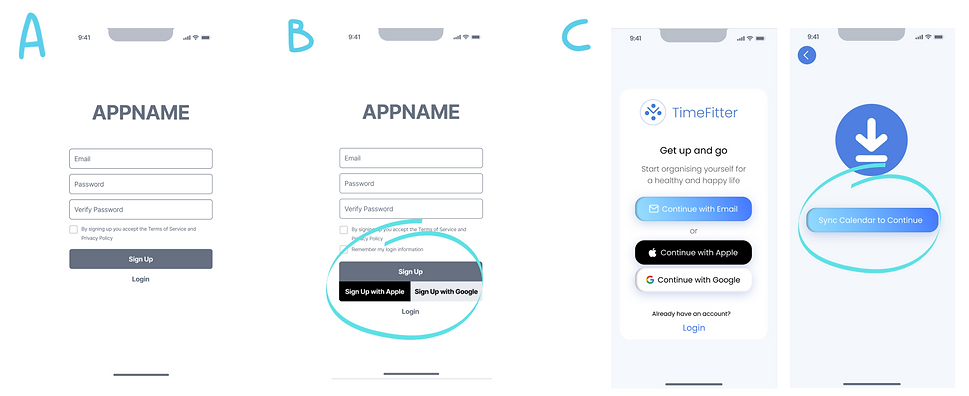TimeFitter
UX Student Case Study
55% of Australians don't meet minimum benchmarks for weekly exercise. TimeFitter is a conceptual product that uses real time analysis of calendar data to find time to fit in exercise, empowering people to become more active.
.png)
Problem Defintion
Our research found that lack of time was a frequently stated obstacle to people exercising more, however when explored further, counter intuitively people also thought that it is easy for most people to fit in regular exercise? The real obstacle appears to be the ability for users to organise their time, plan ahead and feel in control.
Goal: To create a new kind of fitness application that empowers users to take control of their exercise regimes by telling users not only how to work out, but when, empowering them to make long lasting behavior change.
Key Features
Smart Calendar Integration
Using existing calendar information, TimeFitter is able to determine time slots in users week at the push of a button.



Schedule and Build Workouts for You
The thought of what to do and how to do it is another barrier frequently faced by those who aspire to be more active. TimeFitter lets you not only schedule, it will also generate a workout for users.



Design Process
Research
We conducted 10 user interviews with the intent of delving into the multifaceted emotions and decision making process people have. Secondary research pointed to social factors being a key driver to the success in achieving long term activity habits. As part of our pool for interview participants we accounted for.
-
Age - our participants ranged from age 21 through to 56
-
Location - participants spanned rural Victoria to inner Sydney
-
Current exercise frequency - To examine the difference between attitudes of people who were frequent and infrequent in their activity levels we interviewed people who ranged from being almost entirely sedentary to those who exercised more than 12 hours per week.
-
Household situation - ranging from singles living independently to large multi-generational families
Findings
Most respondents found the act of exercising itself easy. On a 1 (easy) to 5 (hard) scale respondents rated exercising itself an average difficulty of 1.8/5
80% of participants saying they felt confident they had access access to exercise options
100% Users were very aware of the benefits of exercise.
Most barriers stated for not exercising more:
-
lack of energy
-
lack of motivation
-
lack of time
Insight:
If users find the task itself easy to do.
Existing options are available
And users want to do it more
How can we remove these barriers?

Now that we know the key barriers are, who are we designing a product for?
Persona: Aspirational Arthur

Arthur knows he needs to exercise more but doesn't have the discipline or guidance to form better habits
Key Characteristics:
Goals:
-
Lack the discipline to meet goals
-
Has ambitions to change their path/life
-
Has a busy life with competing priorities
-
Exercise a little more regularly and be more consistent in being active.
-
Build confidence in developing an active lifestyle.
-
Feel better physically and mentally.
Challenges:
-
Lack of experience in exercising or using health services
-
Lack of time
-
Lack of confidence
-
Managing other life responsibilities and distractions.
-
Limited social interaction with others.
Needs:
Behaviors:
-
A way to help manage his time among other responsibilities.
-
To feel in control and not-judged,
-
Feel encouraged and affirmed
-
Exercises infrequently
-
Avoids uncomfortable situations
-
Struggles to identify opportunities to exercise
""I used to exercise when I was younger, but haven't quite been able to build back the habit! Too much going on."
Customer Journey: Present State

Converting research into ideation
Problem Statement
Arthur's motivation to exercise is regularly sapped by a perceived lack of time and structure in his weekly life. He needs a tool to help organise his time, so that he can exercise more frequently.
How might we...
How might we empower Arthur to take control of his time management, allowing him to structure workouts so he has enough time to complete them and reinforce habit making behaviours
.jpg)
MVP Requirements
-
A product that allows for the scheduling of workouts.
-
A feature that allows integration of his workouts with applications such as google calendar and push notifications.
-
The feature set should favor ease of use and simplicity over ability and detail
-
A feature that demonstrates basic and easy to understand exercise techniques

Future User Flow
Design Iterations
User feedback directed "The ability to log-in with Google would be useful"
Technical constraints: Permission check before syncing with google calendar.

-
Logging out navigation not clear to test users.
-
No way to find "recent workouts" from menu
-
Workout now button took too long to find in testing. Improvement needed to make time finding more proactive.

Integrate working out now with a schedule button to make navigation easier.
Added additional detail panel to provide more information to the user.

Highlighted the next exercise activity to avoid excessive navigation steps
Integrated the new "Find me time" feature with the schedule page.

Future Roadmap
